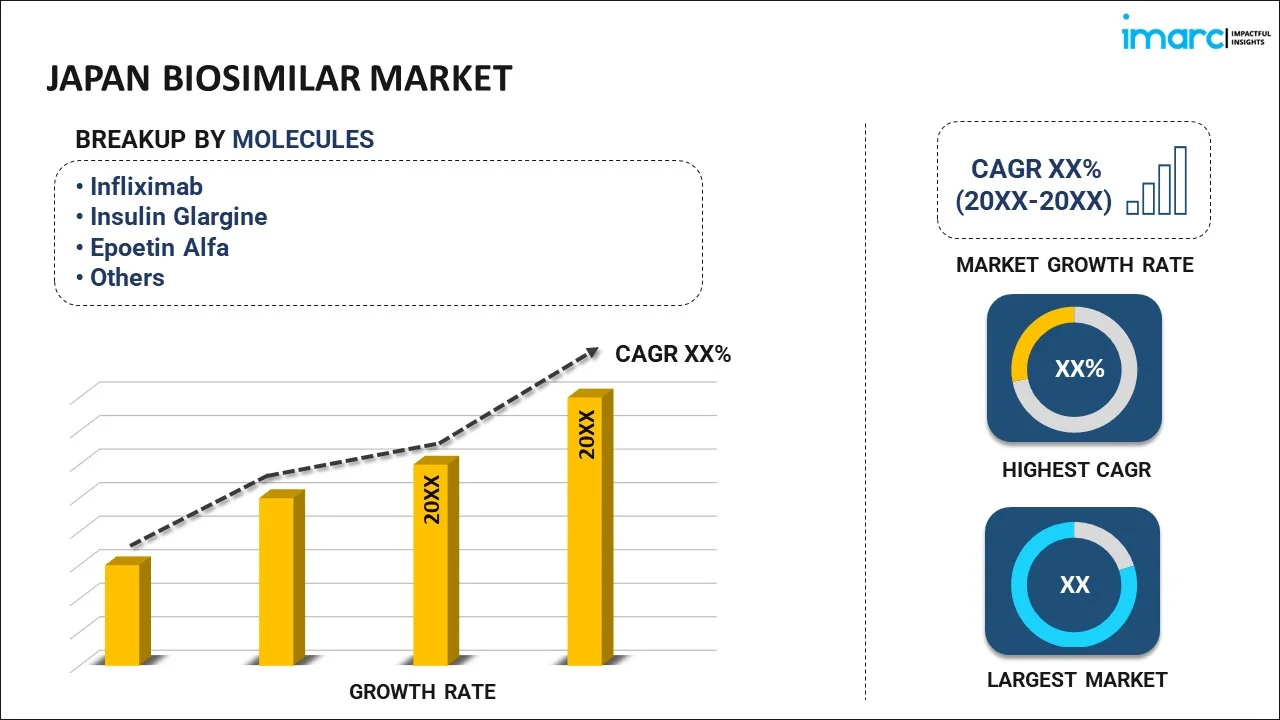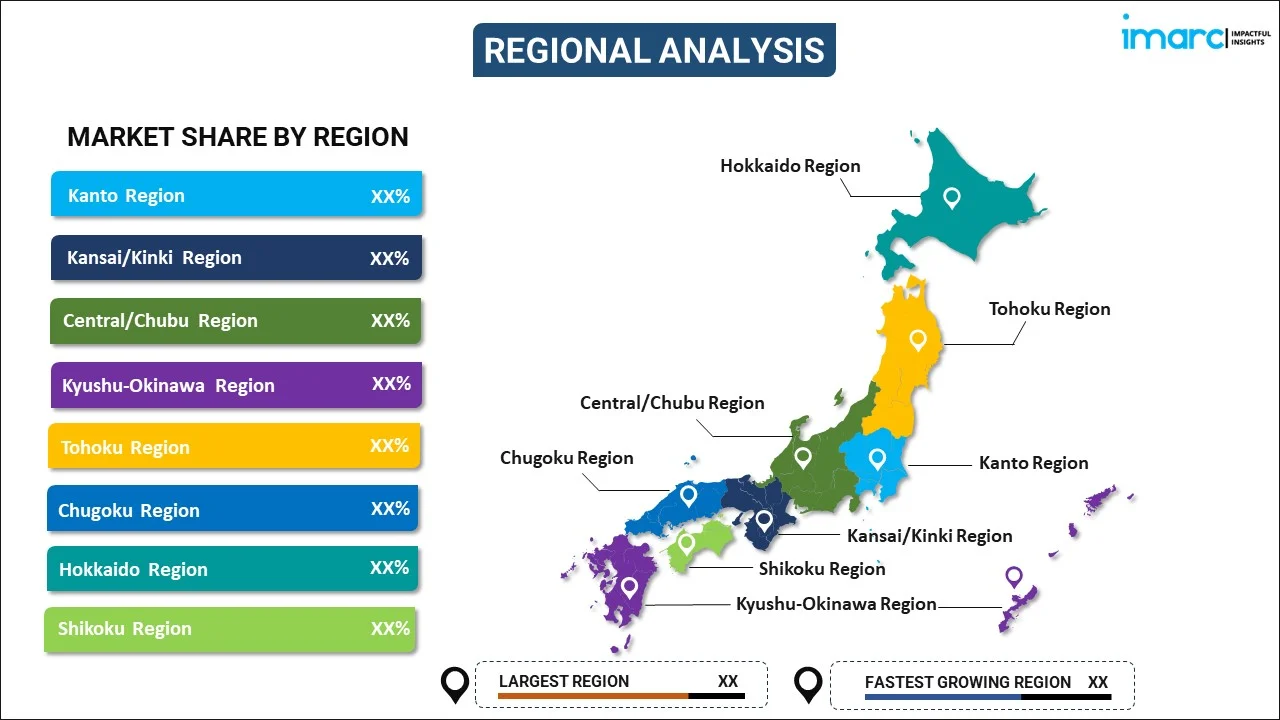
Japan Biosimilar Market Report by Molecule (Infliximab, Insulin Glargine, Epoetin Alfa, Etanercept, Filgrastim, Somatropin, Rituximab, Follitropin Alfa, Adalimumab, Pegfilgrastim, Trastuzumab, Bevacizumab, and Others), Indication (Auto-Immune Diseases, Blood Disorder, Diabetes, Oncology, Growth Deficiency, Female Infertility, and Others), Manufacturing Type (In-House Manufacturing, Contract Manufacturing), and Region 2025-2033
Market Overview:
Japan biosimilar market size reached USD 475.8 Million in 2024. Looking forward, IMARC Group expects the market to reach USD 3,419.6 Million by 2033, exhibiting a growth rate (CAGR) of 22.7% during 2025-2033. The increasing chronic disease prevalence, government initiatives for streamlined approvals, aging population demands, strong pharmaceutical company involvement, cost containment efforts, heightened awareness, and expanding product pipelines represent some of the key factors driving the market.
|
Report Attribute
|
Key Statistics
|
|---|---|
|
Base Year
|
2024
|
|
Forecast Years
|
2025-2033
|
|
Historical Years
|
2019-2024
|
| Market Size in 2024 | USD 475.8 Million |
| Market Forecast in 2033 | USD 3,419.6 Million |
| Market Growth Rate 2025-2033 | 22.7% |
A biosimilar is a biological product that is highly similar to and has no clinically meaningful differences from an existing, already approved reference biologic drug. Compared to generic versions of small-molecule drugs, which are identical replicas of their branded counterparts, biosimilars are large, complex molecules derived from living organisms, such as proteins or antibodies. The development of biosimilars involves a comprehensive comparison with the reference biologic, encompassing aspects like structure, function, and efficacy. Due to the inherent complexity of biologics, it is impossible to produce exact replicas; however, biosimilars are demonstrated to be highly similar in terms of safety and efficacy through rigorous testing and regulatory approval processes. Biosimilars offers a more affordable alternative to expensive biological drug and have gained prominence globally as a means to address the rising costs of healthcare, providing healthcare systems, practitioners, and patients with cost-effective options without compromising therapeutic benefits.
Japan Biosimilar Market Trends:
The increasing prevalence of chronic diseases, such as cancer and diabetes, necessitating cost-effective treatment options is primarily driving the growth of the Japan biosimilar market. In line with this, the Japanese government's initiatives to promote the use of biosimilars, and the introduction of a regulatory framework to expedite the approval process, are significantly fueling the market growth. Moreover, the rising geriatric population in Japan underscores the demand for affordable healthcare solutions, such as biosimilars, strengthening the market growth. Besides this, the strong presence of established pharmaceutical companies investing in biosimilar research and development (R&D) is providing an impetus to the market growth as these companies leverage their expertise and resources to expedite the production and commercialization of biosimilar products. Concurrently, extensive collaborations and partnerships between domestic and international pharmaceutical firms stimulate innovation and widen the scope of biosimilar offerings, which is contributing to the market's growth. Along with this, the push for healthcare cost containment, driven by economic factors, further bolsters the biosimilar market in Japan, as these products provide an avenue for achieving significant cost savings without compromising on treatment efficacy. Additionally, the increasing awareness and acceptance of biosimilars among healthcare professionals and patients, fostering a positive perception of these alternatives, is presenting lucrative opportunities for the market expansion. Furthermore, the growing emphasis on personalized medicine and targeted therapies and the expanding pipeline of biosimilar products encompassing a diverse range of therapeutic areas are creating a positive outlook for the market growth.
Japan Biosimilar Market Segmentation:
IMARC Group provides an analysis of the key trends in each segment of the market, along with forecasts at the country level for 2025-2033. Our report has categorized the market based on molecule, indication, and manufacturing type.
Molecule Insights:

- Infliximab
- Insulin Glargine
- Epoetin Alfa
- Etanercept
- Filgrastim
- Somatropin
- Rituximab
- Follitropin Alfa
- Adalimumab
- Pegfilgrastim
- Trastuzumab
- Bevacizumab
- Others
The report has provided a detailed breakup and analysis of the market based on the molecule. This includes infliximab, insulin glargine, epoetin alfa, etanercept, filgrastim, somatropin, rituximab follitropin alfa, adalimumab, pegfilgrastim, trastuzumab, bevacizumab, and others.
Indication Insights:
- Auto-Immune Diseases
- Blood Disorder
- Diabetes
- Oncology
- Growth Deficiency
- Female Infertility
- Others
A detailed breakup and analysis of the market based on the indication have also been provided in the report. This includes auto-immune diseases, blood disorder, diabetes, oncology, growth deficiency, female infertility, and others.
Manufacturing Type Insights:
- In-House Manufacturing
- Contract Manufacturing
The report has provided a detailed breakup and analysis of the market based on the manufacturing type. This includes in-house manufacturing and contract manufacturing.
Regional Insights:

- Kanto Region
- Kansai/Kinki Region
- Central/ Chubu Region
- Kyushu-Okinawa Region
- Tohoku Region
- Chugoku Region
- Hokkaido Region
- Shikoku Region
The report has also provided a comprehensive analysis of all the major regional markets, which include Kanto Region, Kansai/Kinki Region, Central/ Chubu Region, Kyushu-Okinawa Region, Tohoku Region, Chugoku Region, Hokkaido Region, and Shikoku Region.
Competitive Landscape:
The market research report has also provided a comprehensive analysis of the competitive landscape. Competitive analysis such as market structure, key player positioning, top winning strategies, competitive dashboard, and company evaluation quadrant has been covered in the report. Also, detailed profiles of all major companies have been provided.
Japan Biosimilar Market Report Coverage:
| Report Features | Details |
|---|---|
| Base Year of the Analysis | 2024 |
| Historical Period | 2019-2024 |
| Forecast Period | 2025-2033 |
| Units | Million USD |
| Scope of the Report | Exploration of Historical and Forecast Trends, Industry Catalysts and Challenges, Segment-Wise Historical and Predictive Market Assessment:
|
| Molecules Covered | Infliximab, Insulin Glargine, Epoetin Alfa, Etanercept, Filgrastim, Somatropin, Rituximab, Follitropin Alfa, Adalimumab, Pegfilgrastim, Trastuzumab, Bevacizumab, Others |
| Indications Covered | Auto-Immune Diseases, Blood Disorder, Diabetes, Oncology, Growth Deficiency, Female Infertility, Others |
| Manufacturing Types Covered | In-House Manufacturing, Contract Manufacturing |
| Regions Covered | Kanto Region, Kansai/Kinki Region, Central/ Chubu Region, Kyushu-Okinawa Region, Tohoku Region, Chugoku Region, Hokkaido Region, Shikoku Region |
| Customization Scope | 10% Free Customization |
| Post-Sale Analyst Support | 10-12 Weeks |
| Delivery Format | PDF and Excel through Email (We can also provide the editable version of the report in PPT/Word format on special request) |
Key Questions Answered in This Report:
- How has the Japan biosimilar market performed so far and how will it perform in the coming years?
- What has been the impact of COVID-19 on the Japan biosimilar market?
- What is the breakup of the Japan biosimilar market on the basis of molecule?
- What is the breakup of the Japan biosimilar market on the basis of indication?
- What is the breakup of the Japan biosimilar market on the basis of manufacturing type?
- What are the various stages in the value chain of the Japan biosimilar market?
- What are the key driving factors and challenges in the Japan biosimilar?
- What is the structure of the Japan biosimilar market and who are the key players?
- What is the degree of competition in the Japan biosimilar market?
Key Benefits for Stakeholders:
- IMARC’s industry report offers a comprehensive quantitative analysis of various market segments, historical and current market trends, market forecasts, and dynamics of the Japan biosimilar market from 2019-2033.
- The research report provides the latest information on the market drivers, challenges, and opportunities in the Japan biosimilar market.
- Porter's five forces analysis assist stakeholders in assessing the impact of new entrants, competitive rivalry, supplier power, buyer power, and the threat of substitution. It helps stakeholders to analyze the level of competition within the Japan biosimilar industry and its attractiveness.
- Competitive landscape allows stakeholders to understand their competitive environment and provides an insight into the current positions of Key Players in the market.
Need more help?
- Speak to our experienced analysts for insights on the current market scenarios.
- Include additional segments and countries to customize the report as per your requirement.
- Gain an unparalleled competitive advantage in your domain by understanding how to utilize the report and positively impacting your operations and revenue.
- For further assistance, please connect with our analysts.
 Inquire Before Buying
Inquire Before Buying
 Speak to an Analyst
Speak to an Analyst
 Request Brochure
Request Brochure
 Request Customization
Request Customization




.webp)




.webp)












